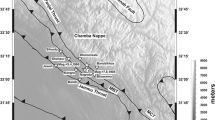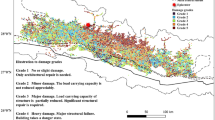Abstract
The method for estimating the site effect on ground motion specified by Borcherdt (1994a, 1994b) is briefly introduced in the paper. This method and the detail geological data and site classification data in San Francisco bay area of California, the United States, are applied to simulate the influenced field of scenario earthquake by GIS technology, and the software for simulating has been drawn up. The paper is a partial result of cooperative research project between China Seismological Bureau and US Geological Survey.
Similar content being viewed by others
References
Algermissen S T. 1982. Probabilistic Estimates of Maximum Acceleration and Velocity in Rock in the Contiguous United States. US Geological Survey Open-File Report, 82-1 033
Algermissien S T. 1991. Probabilistic ground-motion hazard maps of response spectral ordinates for the United States. Fourth International Conference on Seismic Zonation, Proc, Vol. II. Stanford, California, 687–694
Bonilla M G. 1984. Statistical relations among earthquake magnitude, surface length, and surface fault displacement. Bull Seism Soc Amer, 74(6): 2 379–2 412
Boore D M, Joyner W B, Fumal T E. 1997. Equations for estimating horizontal response spectra and peak acceleration from western North American earthquakes: a summary of recent work. Seism Res Lett, 68(1): 128–153
Borcherdt R D. 1994a. Estimates of site-dependent response spectra for design (methodology and justification). Earthquake Spectra, 10(4): 617–653
Borcherdt R D. 1994b. New developments in estimating site effects on ground motion. Seminar on New Development in Earthquake Ground Motion Estimation and Implications for Engineering Design Practice ATC 35-1, Proceedings, 10, 1–44
Borcherdt R D, Wentworth C M. 1991. On the observation and predictive GIS mapping of ground response in the San Francisco Bay region, California. Proceedings of Fourth International Conference on Seismic Zonation, Vol. III, 545–552
Building Seismic Safety Council for Federal Emergency Management Agency. 1994. NEHRP Recommended Provisions for the Development of Seismic Regulations for New Buildings. Vol. I
Campbell K W, Bozorgnia Y. 1994. Near-Source attenuation of peak horizontal acceleration from worldwide accelerograms records from 1957 to 1993. Proceedings of Fifth U.S. National Conference on Earthquake Engineering. Chicago, Illinois
Crouse. 1991. Ground motions attenuation equation for earthquake on the Cascadia Subduction zone. Earthquake Spectra, 7(2): 201–236
Sadigh K E, Egan J A, Youngs R R. 1986. Specification of ground motion for design of long period structures. Earthquake Notes, 57(1): 13–18
Wentworth C M. 1993. General Distribution of Geologic Material in the Southern SanFrancisco Bay Region, California: a Digital Map Database. US Geological Survey, Open-file Report, 93-693
Author information
Authors and Affiliations
Additional information
Contribution No.99FE2018, Institute of Geophysics, China Seismological Bureau.
This subject is supposing by the State Science and Technology Commission, and State Natural Science Foundation of China.
About this article
Cite this article
Zuo, HQ., Xie, LL. & Borcherdt, R.D. Simulation of scenario earthquake influenced field by using GIS. Acta Seimol. Sin. 12, 475–480 (1999). https://doi.org/10.1007/s11589-999-0088-0
Received:
Revised:
Accepted:
Issue Date:
DOI: https://doi.org/10.1007/s11589-999-0088-0




